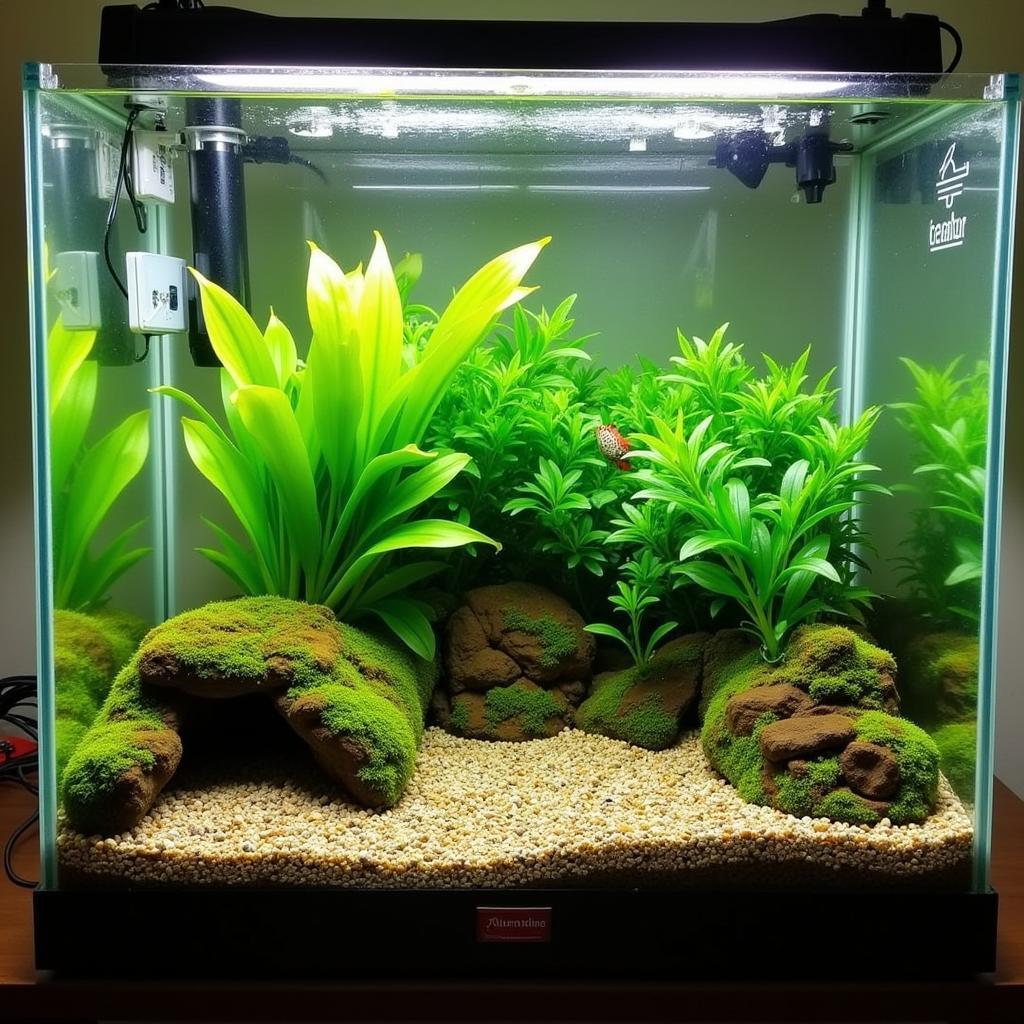African Dwarf Frog Breeding: A Comprehensive Guide
African Dwarf Frog Breeding is a fascinating endeavor that allows enthusiasts to witness the complete life cycle of these charming aquatic creatures. This guide will delve into the intricacies of creating the perfect environment, understanding their breeding behaviors, and raising healthy tadpoles. We’ll cover everything from tank setup and water parameters to feeding habits and potential challenges.
Setting the Stage for African Dwarf Frog Breeding
Creating the ideal breeding environment is crucial for successful African dwarf frog breeding. A dedicated breeding tank, separate from the main aquarium, is highly recommended. This allows for better control over water parameters and prevents disturbances to the breeding pair. The tank should be at least 10 gallons, providing ample space for courtship and egg laying.  African Dwarf Frog Breeding Tank Setup
African Dwarf Frog Breeding Tank Setup
A slightly lower water level than the main tank can stimulate breeding. This mimics the natural conditions of their native habitat during the rainy season, which often triggers breeding behavior. Additionally, a varied diet rich in protein is essential to ensure the frogs are in optimal breeding condition. Think bloodworms, brine shrimp, and high-quality frog pellets.
Dr. Evelyn Mkwizu, a renowned aquatic veterinarian specializing in amphibian care, emphasizes the importance of a balanced ecosystem: “A healthy, established tank with live plants and clean water is the foundation for successful African dwarf frog breeding.”
Understanding Breeding Behaviors and the Mating Ritual
African dwarf frogs exhibit unique breeding behaviors. The males will often “sing” or make a rapid chirping sound to attract females. This can be quite a captivating spectacle. During courtship, the male will clasp onto the female in a process called amplexus. This embrace can last for several hours, during which the female releases eggs and the male fertilizes them.
After mating, the tiny, gelatinous eggs will be scattered throughout the tank, often attached to plants or other surfaces. It’s important to remove the adult frogs after spawning to prevent them from eating the eggs. This is a crucial step in ensuring a healthy tadpole population.
Raising Healthy Tadpoles and Ensuring Their Survival
Once the eggs hatch, the tadpoles will begin their journey to adulthood. They are initially free-swimming and will feed on microscopic organisms in the water. Providing a high-quality liquid fry food or infusoria is essential for their early development. As they grow, their diet can be transitioned to finely ground fish flakes and baby brine shrimp. Regular water changes are crucial for maintaining water quality and preventing the buildup of harmful ammonia.
If you have an African cichlid setup, be sure to keep these larger fish away from the dwarf frog tadpoles, as they may see them as a tasty snack. Want to learn more about African cichlid fish food? Check out this insightful article. For those interested in the differences between African clawed frogs and African dwarf frogs, we have a comprehensive comparison available.
Professor Abasi Ndlovu, a leading herpetologist with years of experience studying African dwarf frogs, notes: “Patience is key when raising tadpoles. Their metamorphosis into frogs can take several weeks, and each stage of development is a marvel to observe.”
Conclusion: A Rewarding Journey into the World of African Dwarf Frog Breeding
African dwarf frog breeding can be a fulfilling experience. By carefully replicating their natural habitat, understanding their breeding behaviors, and providing the proper care for tadpoles, you can contribute to the continuation of this fascinating species. With patience and attention to detail, you’ll be rewarded with the joy of witnessing the entire life cycle of these captivating creatures. If you are curious about sexing your African dwarf frogs, this article on identifying male and female African dwarf frogs will be helpful. Also, check out our guide on African clawed frog pet care for more amphibian care tips.
FAQs
- How long does it take for African dwarf frog eggs to hatch? (Typically 2-3 days.)
- How often should I change the water in the tadpole tank? (25-50% water changes every 2-3 days are recommended.)
- What is the ideal temperature for breeding African dwarf frogs? (75-82°F or 24-28°C.)
- Can I breed African dwarf frogs in my community tank? (It’s not recommended due to potential predation and difficulty controlling water parameters.)
- How long does it take for tadpoles to morph into frogs? (Around 6-8 weeks, depending on environmental conditions.)
- What are the signs of a healthy tadpole? (Active swimming, clear bodies, and a visible appetite.)
- How many eggs do African dwarf frogs typically lay? (Anywhere from 50 to several hundred eggs.)
Do you have questions about other African frog species, like the African clawed frog? We have an article discussing the differences between African clawed frogs and African dwarf frogs. Need help setting up your African cichlid tank? This guide on African cichlid setup will get you started.
For further assistance, please contact us at Phone: +255768904061, Email: kaka.mag@gmail.com or visit our office at Mbarali DC Mawindi, Kangaga, Tanzania. Our customer service team is available 24/7.



